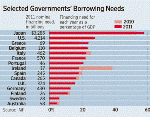 $10.2 trillion: The amount of money advanced-nation governments will need to borrow in 2011. As the debts of advanced countries rise to levels not seen since the aftermath of World War II, it’s hard to know how much is too much. But it’s easy to see that the risk of serious financial trouble is growing.Next year, fifteen major developed-country governments, including the U.S., Japan, the U.K., Spain and Greece, will have to raise some $10.2 trillion to repay maturing bonds and finance their budget deficits, according to estimates from the International Monetary Fund. That’s up 7% from this year, and equals 27% of their combined annual economic output.
$10.2 trillion: The amount of money advanced-nation governments will need to borrow in 2011. As the debts of advanced countries rise to levels not seen since the aftermath of World War II, it’s hard to know how much is too much. But it’s easy to see that the risk of serious financial trouble is growing.Next year, fifteen major developed-country governments, including the U.S., Japan, the U.K., Spain and Greece, will have to raise some $10.2 trillion to repay maturing bonds and finance their budget deficits, according to estimates from the International Monetary Fund. That’s up 7% from this year, and equals 27% of their combined annual economic output.
Aside from Japan, which has a huge debt hangover from decades of anemic growth, the U.S. is the most extreme case. Next year, the U.S. government will have to find $4.2 trillion. That’s 27.8% of its annual economic output, up from 26.5% this year. By comparison, crisis-addled Greece needs $69 billion, or 23.8% of its annual GDP.
So far, with the notable exception of Greece, major advanced nations haven’t had too much trouble raising the money they need. Japan’s domestic investors have consistently bought its government bonds despite their low yield. Foreign investors have been snapping up U.S. Treasury bonds, which remain the world’s premier safe-haven investment.
Still, there’s reason to be concerned that governments’ appetite for borrowing could ultimately push up interest rates, or worse.
For one, government borrowers are tapping into smaller international capital flows. The total amount of foreign portfolio investment sloshing in across advanced countries’ borders averaged about 3.8% of global GDP in the twelve months ended June, compared to an average 9.5% in the eight years leading up to the recession.
Beyond that, the U.S. and other advanced nations are putting pressure on China to allow its currency to appreciate against the dollar. All else equal, such a move would curb demand for dollar-denominated debt from a country that is the largest foreign holder of U.S. Treasurys.
In the U.S., domestic investors could pick up the slack. The Federal Reserve has committed to buy an added $600 billion in U.S. government debt over the next eight months. Demand from households has been very strong as U.S. consumers boost their savings rate. Tighter regulations could push banks to buy more safe assets such as U.S. Treasurys.
But as the IMF warned in a report this week, the chances that investors will balk at lending to governments “remains high for advanced economies.” That’s a highly undesirable outcome – picture a financial crisis in which governments can’t step in to help, because government finances are the problem. We can’t know how close we are to such an outcome, and the need to keep the recovery going would make cutting back now a risky move. Ultimately, though, we’re heading in the wrong direction.
{WSJ Economics/Matzav.com}











